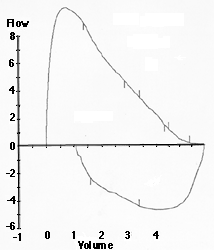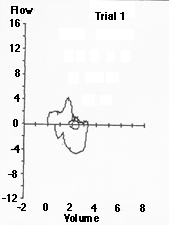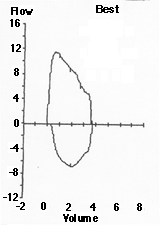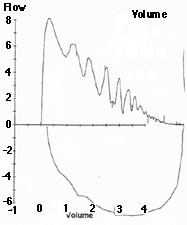Normal

Variable Effort

Early Glottic Closure

Cough

Interpretation of Pulmonary Function Tests: Spirometry
Thomas Gross, MD
Peer Review Status: Externally Peer Reviewed by the Department of Internal Medicine Virtual Hospital Editorial Board
Obtaining useful information from pulmonary function tests requires both adequate equipment and reproducible performance. If these requirements are not met, the results must be interpreted with caution.
The American Thoracic Society (ATS) has published guidelines for the standardization of spirometry equipment and performance. Spirometric equipment should be selected to meet ATS recommendations, and at least daily monitoring and calibration must be done to obtain consistent and accurate PFT's.
Many physicians, however, are not involved in the selection of the equipment used for testing or its maintenance. But because spirometry is such an effort dependent test, they should examine each spirogram using performance criteria as set forth by the ATS. These include criteria for acceptability and reproducibility.
Criteria for acceptability include:
Criteria for reproducibility after obtaining three acceptable spirograms include:
An acceptable spirogram should not be discarded even if it cannot be reproduced. Up to eight efforts may be performed in order to meet acceptability and reproducibility criteria. Beyond eight efforts, fatigue may play a role in the results, and additional efforts are not warranted. When reporting the actual values obtained from spirometry, the highest FEV1 and FVC should be reported and may be from different efforts. By contrast, FEF25-75, flow volume, and volume time curves should be reported from the best test curve. This is defined as the acceptable curve with the largest sum of FVC and FEV1.
Ensuring adequate patient effort depends on the technician measuring spirometry. The patient should be well coached and instructed throughout the test while the technician evaluates both the patient's effort and the spirograms. Meeting reproducibility criteria helps to ensure adequate effort because maximal patient effort leads to more reproducible results.
When interpreting PFT's, it is useful to keep the ATS guidelines in mind. Frequently not all the criteria are met, and this may limit the reliability of the test if the results are abnormal. If the spirometric results are normal, the test can be interpreted as normal even though all criteria may not be met.
Test acceptability is best determined by examining the flow volume loop and volume time curve. Variable effort, cough, and early glottic closure can be seen on the graphs but may not be apparent by simply looking at values for FEV1 and FVC.
|
Normal
|
Variable Effort
|
|
Early Glottic Closure
|
Cough
|
Variable effort can be detected by a flow volume loop that fails to demonstrate the normal early peak, showing that the patient failed to expire maximally when instructed to do so. Early glottic closure is seen as an abrupt cessation of flow during expiration, visible as a sharp downslope on the expiratory flow volume curve. Coughing during spirometry appears as sudden sharp spikes in the decreasing limb of the flow volume curve.
By examining the flow volume loops, the quality of a spirogram can be assessed. In addition, the technician working with the patient should comment on the patient's effort and the session as a whole. At least three efforts must be attempted to meet reproducibility criteria.